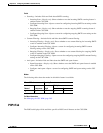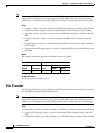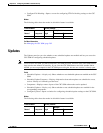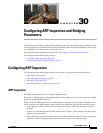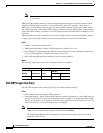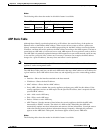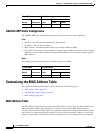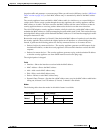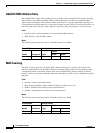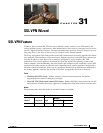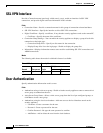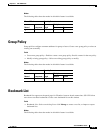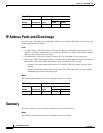
30-5
Cisco ASDM User Guide
OL-16647-01
Chapter 30 Configuring ARP Inspection and Bridging Parameters
Customizing the MAC Address Table
drops the traffic and generates a system message. When you add a static ARP entry (see the “ARP Static
Table” section on page 30-3), a static MAC address entry is automatically added to the MAC address
table.
The security appliance learns and builds a MAC address table in a similar way as a normal bridge or
switch: when a device sends a packet through the security appliance, the security appliance adds the
MAC address to its table. The table associates the MAC address with the source interface so that the
security appliance knows to send any packets addressed to the device out the correct interface.
The ASA 5505 adaptive security appliance includes a built-in switch; the switch MAC address table
maintains the MAC address-to-switch port mapping for traffic within each VLAN. This section discusses
the bridge MAC address table, which maintains the MAC address-to-VLAN interface mapping for traffic
that passes between VLANs.
Because the security appliance is a firewall, if the destination MAC address of a packet is not in the table,
the security appliance does not flood the original packet on all interfaces as a normal bridge does.
Instead, it generates the following packets for directly connected devices or for remote devices:
• Packets for directly connected devices—The security appliance generates an ARP request for the
destination IP address, so that the security appliance can learn which interface receives the ARP
response.
• Packets for remote devices—The security appliance generates a ping to the destination IP address
so that the security appliance can learn which interface receives the ping reply.
The original packet is dropped.
Fields
• Interface—Shows the interface associated with the MAC address.
• MAC Address—Shows the MAC address.
• Add—Adds a static MAC address entry.
• Edit—Edits a static MAC address entry.
• Delete—Deletes a static MAC address entry.
• Dynamic Entry Timeout—Sets the time a MAC address entry stays in the MAC address table before
timing out, between 5 and 720 minutes (12 hours). 5 minutes is the default.
Modes
The following table shows the modes in which this feature is available:
Firewall Mode Security Context
Routed Transparent Single
Multiple
Context System
—
• • •—



